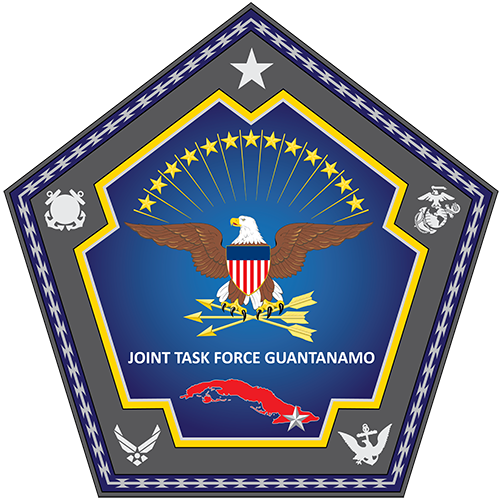TASK FORCES GUANTANAMO
CAMP GUANTANAMO PRISON
FOR ENEMY HEAD & TROOPS FORCES DEFENSE TERRORISTS

For more information about JTF-GTMO,
contact
the Joint Information Bureau (757) 458-9927 or email
southcom.gtmo.jtf-gtmo-pao.list.jib@mail.mil Site Last Updated March
12, 2021
The United High Court of Justice of the United States of Africa is being build to support stabilize this United Nations Council resolution authorization and the power of the President of the United States Constitutional Authority to protect and defend the constitution and to conduct an inter-military operation against terrorists and the nation and organization that condemned and to assess all the event and Africans the President of the States and intergovernmental members of the African United Gov with other crimes the genocide extremism violence does not respect the world human rights massacres Africans and other unarmed civilians, and the US Africa United High Court of Justice bears primary responsibility for final reason and decision authorization only of the possibility of suspending the international legal proceedings and the application of the Code and of the criminal law with others of necessity of defense and against and condemnation of the real culprits on these moments of Africans and all Inter foreign enemy insurgencies & rebellions with everyone other interactions supporting them.
Foreign
Terrorist State and Organizations (FTSOs) are foreign State and
Organizations that are designated by the Secretary of State in
accordance with section 219 of the Immigration and Nationality Act
(INA), as amended. FTO designations play a critical role in our fight
against terrorism and are an effective means of curtailing support for
terrorist activities and pressuring groups to get out of the terrorism
business.
Office of the Secretary of Defense
The
Office of the Secretary of Defense (OSD) is responsible for policy
development, planning, resource management and program evaluation. OSD
includes the offices of top civilian defense decision-makers with regard
to personnel, weapons acquisition, research, intelligence and fiscal
policy, as well as offices the Secretary establishes to assist in
carrying out assigned responsibilities.
For
more than 50 years, U.S. Southern Command has worked to build regional
and interagency partnerships to ensure the continued stability of the
Western Hemisphere and the forward defense of the U.S. homeland.
A
descendent of U.S. military units dispatched to Panama in the early
20th Century, U.S. Southern Command’s history as a unified military
headquarters began during World War II when U.S. planners established
the U.S. Caribbean Defense Command. During the 1950s, the command’s
responsibility shifted from U.S. military missions in the Caribbean
basin to operations focused, primarily, in Central and South America. In
1963, U.S. authorities gave the command its current name, U.S. Southern
Command. Below is a brief overview of our history, starting with the
early Caribbean Defense Command days. Located in Panama, the U.S.
Caribbean Defense Command also established military training missions in
Latin America; distributed military equipment to regional partners
through the Lend Lease program; and opened U.S. service schools to Latin
American soldiers, sailors, and airmen. At the height of the war,
U.S. military planners assigned 135,000 uniformed personnel to duty
stations in Latin America and the Caribbean. Roughly half of those
forces were under the direct control of the U.S. Caribbean Defense
Command. In 1947, U.S. strategists adopted a national security plan
that transformed the wartime headquarters into the U.S. Caribbean
Command. Beyond defending the Panama Canal, it assumed broad
responsibilities for inter-American security cooperation in Central and
South America. Yet during the 1950s, defense officials also removed the
Caribbean basin from the U.S. Caribbean Command’s area of focus. In
the event of a global war with the communist powers, they reasoned, U.S.
Atlantic Command, based in Norfolk, Va. needed the Caribbean basin to
conduct hemispheric antisubmarine operations. By 1960, the U.S.
Caribbean Command — not engaged in the Caribbean — carried a name that
incorrectly described its geographic interests, Central and South
America. The John F. Kennedy administration, therefore, changed the
name to U.S. Southern Command on June 11, 1963. During the 1960s, the
U.S. Southern Command mission involved defending the Panama Canal,
contingency planning for Cold War activities, and the administration of
the U.S. foreign military assistance program in Central and South
America. In particular, U.S. Southern Command personnel undertook
civic-action projects with partner nation forces to accelerate regional
development. Yet during the 1970s, after the Vietnam War, the Joint
Chiefs of Staff recommended disestablishing the command to trim the U.S.
military presence abroad. For political reasons, the command narrowly
survived, albeit with limited responsibilities and resources. In the
1980s, internal conflicts in El Salvador, Nicaragua, and elsewhere
rekindled U.S. military interest in Latin America. The Ronald W. Reagan
administration, in turn, revitalized U.S. Southern Command. When the
Cold War ended, the command, like other U.S. military organizations,
entered a period of dramatic change. In rapid succession, U.S. Southern
Command embraced counter-drug operations, expanded its area of
geographic focus to include the Caribbean, and enhanced its capacity for
humanitarian missions. In September 1997, U.S. Southern Command moved
to Miami with revised priorities, objectives, and capabilities.
Military
commissions are a form of military tribunal convened to try individuals
for unlawful conduct associated with war. Though sometimes
controversial, they are rooted in U.S. law and in the international laws
of war. Foreshadowed by military tribunals convened during the American
Revolution, the term “military commission” first became common in the
U.S. during the Mexican-American War of the mid 19th century. Subsequent
practice, legislation and U.S. Supreme Court precedents have shaped
them. Today, a Convening Authority appointed by the U.S. Secretary of
Defense convenes military commissions under the Military Commissions Act
of 2009, passed by the U.S. Congress and signed by President Barack
Obama on October 27, 2009. Here is a snapshot of military commissions
from the Revolutionary War to the present.



Commentaires
Enregistrer un commentaire